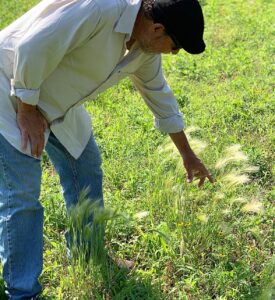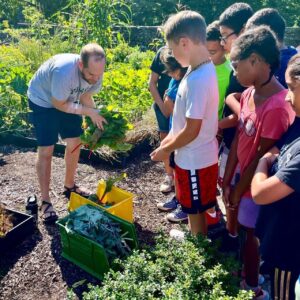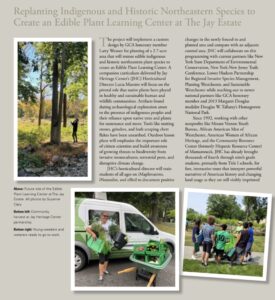
The Jay Heritage Center is thrilled to announce that it is the 2024 recipient of The Garden Club of America’s (GCA) Founders Fund Award. The project was generously proposed by longtime JHC supporters The Little Garden Club of Rye and seconded by The Rye Garden Club.
This national award was established in 1934 to provide financial support, through a competitive grant program, to projects proposed by GCA member clubs. The projects are designed to restore, improve, and protect the quality of the environment through educational programs and action in the fields of conservation and civic improvement. This year the $40,000 winning grant was awarded to JHC for the purpose of Replanting Indigenous and Historic Northeastern Species to Create an Edible Plant Learning Center at the Jay Estate. Over 199 garden clubs across the country reviewed three outstanding finalists and voted. The winner and two $10,000 runners-up were announced at the GCA Annual Meeting in Hartford, Connecticut on Saturday, April 27th.
The Edible Plant Learning Center at the Jay Estate is the first Founders Fund project winner for either the Little Garden Club or Rye of the Rye Garden Club since the award was created. It is the first project in Westchester County to earn this distinction. The last project in New York State to win a Founders Fund award was for a Buffer Strip Planting to help with stormwater runoff in Cooperstown, NY in 2008.*
JHC President Suzanne Clary remarked, “It was a privilege to be considered alongside two other incredible native plant restoration projects at Pine Jog in Palm Beach, Florida and Church Health Community Gardens in Memphis, Tennessee. We are immensely grateful to the many Garden Club of America members who have supported our non-profit’s rebuilding of habitat and native plant education efforts for well over a decade. We extend special thanks to Jean Cawley Taplett of the Little Garden Club of Rye and Lisa Wallace of the Rye Garden Club for shepherding this exciting new project through to success. This transformational gift brings national recognition to the increased urgency for conservation efforts to protect biodiversity and natural heritage.” Clary, who is 25-year member of the Rye Garden Club assisted with the submission which was many years in the making.
The project will implement a custom design by GCA Honorary Member Larry Weaner for planting of a 2.7-acre area that will restore edible indigenous and historic north eastern plants species to create an Edible Plant Learning Center. A companion curriculum delivered by Jay Heritage Center’s Horticultural Director Lucia Maestro will focus on the pivotal role that native plants have played in healthy and sustainable human and wildlife communities. Artifacts found during archaeological exploration attest to the presence of Indigenous peoples and their reliance upon native trees and plants for sustenance and more. Tools like nutting stones, grinders and bark scraping chert flakes have been unearthed on the property during supervised digs. Outdoor lesson plans will emphasize the important role of citizen scientists, and build awareness of growing threats to biodiversity from invasive monocultures, terrestrial pests and disruptive climate change. This will be the second collaboration between JHC and Larry Weaner’s firm.

JHC’s Horticultural Director will train students of all ages on iMAP Invasives, iNaturalist, and eBird to document positive changes in the newly fenced-in planted area and compare with an adjacent control area. JHC will collaborate on this program with current local partners like New York State Department of Environmental Conservation (NYDEC), New-York New Jersey Trails Conference, Lower Hudson Partnership for Regional Invasive Species Management (LHPRISM), Planting Westchester, Sustainable Westchester and national partners like GCA Honorary Member and 2013 Margaret Douglas Medalist Doug Tallamy co-founder of Homegrown National Park. Tallamy recently spoke at JHC to a capacity crowd in honor of Native Plant Month.
Since 1992, working with other nonprofits like the Mount Vernon Youth Bureau, the African American Men of Westchester, the American Women of African Heritage (AWAH), and the Community Resource Center (formally Hispanic Resource Center) of Mamaroneck, JHC has already brought thousands of fourth through ninth grade students, primarily from Title I schools, for free, interactive tours, that interpret powerful narratives of American history and changing land usage, as they are still visibly imprinted in the landscape. These students and their families will be among those to benefit from this new native classroom.
The plantings will include native vegetation with high wildlife value: pawpaw trees, elderberry, and blueberry bushes, with particular attention to species hosting native butterflies, songbirds, and pollinators present within the region; the project will have structural diversity (herb, shrub, and tree layers) associated with habitat quality; and enhance wildlife for diversity by emphasizing morphological variety, fruiting plants, blooms across the season, and vegetation documented to host a wide variety of insects; interface with nearby areas to increase habitat value; and include native edible perennial species for foraging by humans. JHC synthesizes the best management practices and technology in landscape restoration and historic preservation while also incorporating new methods of adaptive reuse and green innovation. In this respect, they serve as a model to others and are a veritable laboratory of ideas.

As one of approximately 2600 National Historic Landmark sites in the country, the Jay Estate is a rare, cultural and natural sanctuary, which illustrates the changing stewardship of land in the United States over a well documented continuum of 10,000 years. The property once belong to the Wiechquaesgeck people and JHC has hosted numerous programs about the land’s Indigenous history. It was also the home of enslaved African-American families who maintained the landscape and gardens before being freed through the Jay family’s anti-slavery advocacy in New York State.

A list of Founders Fund winners from New York is as follows:
Fun fact! The Jay Estate’s association with The Garden Club of America dates back over 100 years. Jay descendant Mary Rutherfurd Jay who grew up at the Jay Estate was an award-winning landscape architect, author, WWI volunteer and member of the Orange and Dutchess County Garden Club (who submitted a winning Founders Fund project in 1938!) In addition to designing numerous gardens, lecturing and leading garden tours abroad with GCA members, Mary was also a GCA flower show judge.


